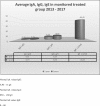10-year experience with umbilical cord blood IgE and microbiome therapy
- PMID: 30857564
- PMCID: PMC6413446
- DOI: 10.1186/s13052-019-0620-3
10-year experience with umbilical cord blood IgE and microbiome therapy
Abstract
Background: The benefit of probiotics in newborn children in relation to allergy and general morbidity later in life appears to be controversial. Allergic diseases represent an increasingly important health problem worldwide in recent years. This is evident in all age groups. The occurrence of allergic illnesses also continues to rise exponentially, and thus the use of preventive and prognostic methods, particularly in children with an inherently higher risk of allergy, is gaining increased importance. Since the advent of probiotics the effect of probiosis on immunity through alterations of composition and function of the human gut microbiome has been increasingly studied. The exact mechanisms have not yet been clearly defined. The Academy of Sciences of the Czech Republic (The Czech Academy of Sciences has suggested that the expression of TH1 and TH2 cytokines in umbilical blood is associated with an increased risk of allergies. The counter -balance of Th1 and Th2 affect Immunoglobulin E (IgE) production and maturation of the gastrointestinal tract epithelium.
Case presentation: We examined IgE levels in 3000 samples of umbilical blood taken from children born into families with a positive history of allergy in one or both parents from 2007 to 2017. At the age of ten days, those with high IgE were given Colinfant Newborn (a lyophilized non-pathogenic strain of Escherichia.coli) for one month, three times weekly. At 15 months and three years we investigated the levels of Immunoglobulins E,A and G, and the incidence of illness and allergy. The results revealed that allergy and high umbilical IgE is strongly linked with family history (p ≤ 0.001). We also detected differences in seasonality, especially with regards to pollen allergies. Eighty percent of children treated with Colinfant Newborn had significantly reduced IgE and morbidity at 13-15 months and 3 years, and furthermore without any clinical signs of allergy. Normalization of Immunoglobulins A and G was seen in 90% of treated subjects (p ≤ 0.001). These levels significantly correlated with an almost negligible morbidity up to 4 years of life. Colinfant Newborn, a lyophilized strain of Esherichia coli (E. coli), and a normal component of intestinal flora, readily colonizes the intestinal tract. It's long term presence significantly stimulates the production of specific and non-specific intestinal antibodies. and optimalizes immune development through tolerance. In our study Colinfant Newborn reduced the incidence of infections later in life by safely and effectively normalizing immunoglobulin levels in the majority of treated patients.
Conclusion: Our study strongly suggests as positive effect of physiological Escherichia coli on the microbiome of newborn children as evidenced by a significantly reduced incidence of allergy and morbidity when applied early in life. These benefits appear to be strongly strain specific.
Keywords: Allergy; Immunology; Microbiome; Newborn; Probiotics.
Conflict of interest statement
Ethics approval and consent to participate
This article does not contain any studies with human participants or animals performed by any of the authors.
The database research protocol was approved by the local ethics committee (April, 2002) and it conforms to the provisions of the Declaration of Helsinky in 1995 (as revised in Edinburgh 2000), the International Conference on Harmonisation Guidlines for Good Clinical Practice (ICH- GCP) and local and national requirements. All parents and/or legal guardians gave their informed written consent prior to participation in the study and their anonymity was preserved.
Consent for publication
Parents’ consent for publication was obtained.
Informed consent was obtained from all individual participants included in the study.
Competing interests
J. Liška declares that he has no conflict of interest. The authors declare that they have no competing interests.
Publisher’s Note
Springer Nature remains neutral with regard to jurisdictional claims in published maps and institutional affiliations.
Figures
References
MeSH terms
Substances
LinkOut - more resources
Full Text Sources
Medical




